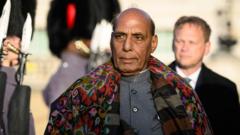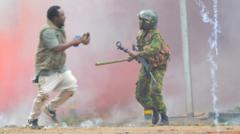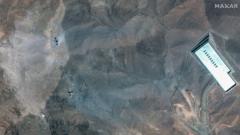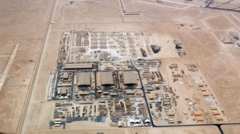As India accuses Pakistan of initiating drone and missile attacks on its territories, and Pakistan claims to have intercepted Indian drones, the situation escalates. Experts warn this new phase could deepen the conflict between the two nations, highlighting the role of unmanned aerial vehicles in modern warfare.**
The Dawn of Drone Warfare: India and Pakistan Escalate Their Conflict**
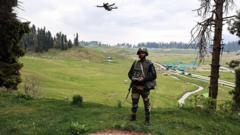
The Dawn of Drone Warfare: India and Pakistan Escalate Their Conflict**
The ongoing tensions between India and Pakistan take a dramatic turn as both nuclear-armed nations engage in a series of drone strikes, marking a significant development in their long-standing rivalry.**
In a significant escalation of military hostilities, India and Pakistan have entered into what experts describe as the world's first drone war between two nuclear-armed states. The conflict ignited this Thursday when India accused Pakistan of launching a barrage of drones and missiles at several military installations in Indian-administered Kashmir. Pakistan, in turn, has vehemently denied these allegations, claiming to have successfully shot down 25 Indian drones in recent hours.
This new chapter of aerial confrontations comes at a perilous time for both nations, which share a long and tumultuous history marked by territorial disputes and military conflict. With armies now exchanging unmanned aerial strikes across a volatile border, experts point to the use of drones as a potentially transformative factor in the ongoing rivalry, akin to an arms race between the two neighbors.
"The Indo-Pak conflict is evolving; with unmanned precision strikes being deployed, the landscape of warfare may witness a significant change where mastering drone technology becomes a key determinant," notes Jahara Matisek, a security analyst at the US Naval War College. With each side claiming civilian casualties and airspace violations, the situation indicates a notable shift in military tactics.
Since the onset of these drone skirmishes, Pakistani officials report that Indian air strikes and cross-border shelling have resulted in numerous deaths and injuries, while India counters that its missile retaliation was provoked by a deadly militant assault in Pahalgam last month, an incident Pakistan denies involvement in.
In a tactical twist, Pakistan's military asserted that it successfully neutralized Indian air assets using a variety of methods, while India communicated objectives aimed at countering Pakistani air defenses. Now, both nations appear to be actively developing a sophisticated drone arsenal as central components of their military strategies.
India's emphasis on Israeli-manufactured drones and loitering munitions is reshaping its operational capabilities. Analysts point out that significant acquisitions, including over 30 US MQ-9B Predator drones, signal a substantial enhancement of India's drone warfare potential.
Similarly, Pakistan's air defense strategies also reflect an extensive use of drones, incorporating both domestic and imported systems, highlighting an ongoing competition in drone technology that showcases each side's commitment to modernize their military forces with advanced UAV capabilities.
While some defense experts argue that the recent drone strikes signify a moment of tactical engagement, they caution that this could lead to either a de-escalation or a larger conflict. The future of the India-Pakistan rivalry is poised at a critical juncture, where every aerial exchange risks igniting further hostilities.
As geopolitical tensions rise and global powers urge for calm, the integration of drones into their military operations creates new dynamics in a decades-long conflict. The implications of integrating unmanned warfare technologies not only alter traditional military confrontations but also raise critical questions regarding escalation in a region where both countries possess nuclear capabilities.
In this high-stakes game of drone warfare, the potential for miscalculation looms large, as each side reacts to perceived threats in an already heated environment, making clear that the stakes have never been higher in this ongoing struggle for dominance.
This new chapter of aerial confrontations comes at a perilous time for both nations, which share a long and tumultuous history marked by territorial disputes and military conflict. With armies now exchanging unmanned aerial strikes across a volatile border, experts point to the use of drones as a potentially transformative factor in the ongoing rivalry, akin to an arms race between the two neighbors.
"The Indo-Pak conflict is evolving; with unmanned precision strikes being deployed, the landscape of warfare may witness a significant change where mastering drone technology becomes a key determinant," notes Jahara Matisek, a security analyst at the US Naval War College. With each side claiming civilian casualties and airspace violations, the situation indicates a notable shift in military tactics.
Since the onset of these drone skirmishes, Pakistani officials report that Indian air strikes and cross-border shelling have resulted in numerous deaths and injuries, while India counters that its missile retaliation was provoked by a deadly militant assault in Pahalgam last month, an incident Pakistan denies involvement in.
In a tactical twist, Pakistan's military asserted that it successfully neutralized Indian air assets using a variety of methods, while India communicated objectives aimed at countering Pakistani air defenses. Now, both nations appear to be actively developing a sophisticated drone arsenal as central components of their military strategies.
India's emphasis on Israeli-manufactured drones and loitering munitions is reshaping its operational capabilities. Analysts point out that significant acquisitions, including over 30 US MQ-9B Predator drones, signal a substantial enhancement of India's drone warfare potential.
Similarly, Pakistan's air defense strategies also reflect an extensive use of drones, incorporating both domestic and imported systems, highlighting an ongoing competition in drone technology that showcases each side's commitment to modernize their military forces with advanced UAV capabilities.
While some defense experts argue that the recent drone strikes signify a moment of tactical engagement, they caution that this could lead to either a de-escalation or a larger conflict. The future of the India-Pakistan rivalry is poised at a critical juncture, where every aerial exchange risks igniting further hostilities.
As geopolitical tensions rise and global powers urge for calm, the integration of drones into their military operations creates new dynamics in a decades-long conflict. The implications of integrating unmanned warfare technologies not only alter traditional military confrontations but also raise critical questions regarding escalation in a region where both countries possess nuclear capabilities.
In this high-stakes game of drone warfare, the potential for miscalculation looms large, as each side reacts to perceived threats in an already heated environment, making clear that the stakes have never been higher in this ongoing struggle for dominance.

